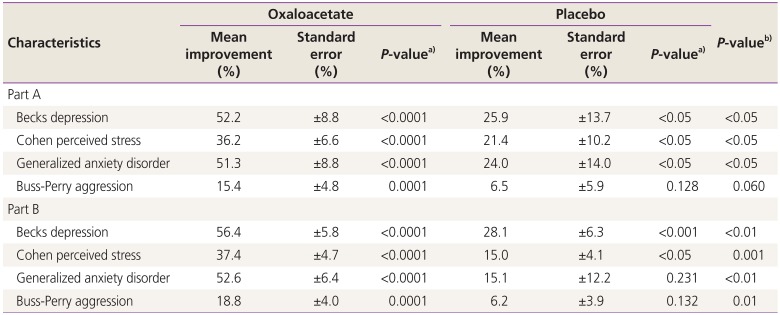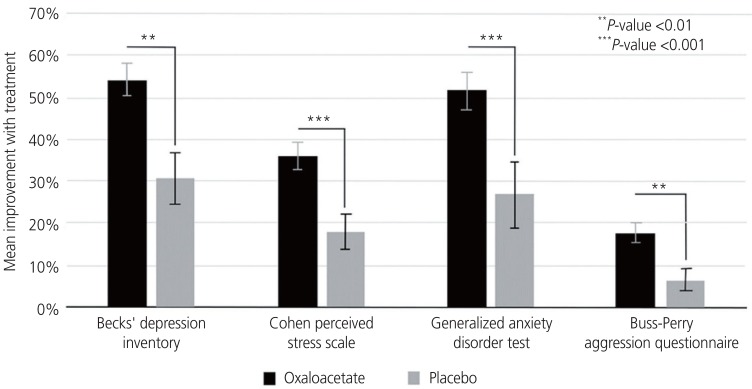1. Zendehdel M, Elyasi F. Biopsychosocial etiology of premenstrual syndrome: a narrative review. J Family Med Prim Care. 2018; 7:346–356. PMID:
30090776.

2. Hoyer J, Burmann I, Kieseler ML, Vollrath F, Hellrung L, Arelin K, et al. Menstrual cycle phase modulates emotional conflict processing in women with and without premenstrual syndrome (PMS)--a pilot study. PLoS One. 2013; 8:e59780. PMID:
23637739.
3. Beck AT, Beamesderfer A. Assessment of depression: the depression inventory. Mod Probl Pharmacopsychiatry. 1974; 7:151–169. PMID:
4412100.

4. Beck AT, Epstein N, Brown G, Steer RA. An inventory for measuring clinical anxiety: psychometric properties. J Consult Clin Psychol. 1988; 56:893–897. PMID:
3204199.

5. Löwe B, Decker O, Müller S, Brähler E, Schellberg D, Herzog W, et al. Validation and standardization of the Generalized Anxiety Disorder Screener (GAD-7) in the general population. Med Care. 2008; 46:266–274. PMID:
18388841.

6. Andreou E, Alexopoulos EC, Lionis C, Varvogli L, Gnardellis C, Chrousos GP, et al. Perceived Stress Scale: reliability and validity study in Greece. Int J Environ Res Public Health. 2011; 8:3287–3298. PMID:
21909307.

7. Lee EH. Review of the psychometric evidence of the perceived stress scale. Asian Nurs Res. 2012; 6:121–127.

8. Diamond PM, Magaletta PR. The short-form Buss-Perry Aggression Questionnaire (BPAQ-SF): a validation study with federal offenders. Assessment. 2006; 13:227–240. PMID:
16880276.
9. Rapkin AJ, Berman SM, Mandelkern MA, Silverman DH, Morgan M, London ED. Neuroimaging evidence of cerebellar involvement in premenstrual dysphoric disorder. Biol Psychiatry. 2011; 69:374–380. PMID:
21092938.

10. Wolf U, Rapoport MJ, Schweizer TA. Evaluating the affective component of the cerebellar cognitive affective syndrome. J Neuropsychiatry Clin Neurosci. 2009; 21:245–253. PMID:
19776302.

11. Kimbrell TA, Ketter TA, George MS, Little JT, Benson BE, Willis MW, et al. Regional cerebral glucose utilization in patients with a range of severities of unipolar depression. Biol Psychiatry. 2002; 51:237–252. PMID:
11839367.

12. Schmahmann JD, Weilburg JB, Sherman JC. The neuropsychiatry of the cerebellum - insights from the clinic. Cerebellum. 2007; 6:254–267. PMID:
17786822.

13. Schmahmann JD, Caplan D. Cognition, emotion and the cerebellum. Brain. 2006; 129:290–292. PMID:
16434422.

14. Schmahmann JD. The role of the cerebellum in cognition and emotion: personal reflections since 1982 on the dysmetria of thought hypothesis, and its historical evolution from theory to therapy. Neuropsychol Rev. 2010; 20:236–260. PMID:
20821056.

15. Trout KK, Basel-Brown L, Rickels MR, Schutta MH, Petrova M, Freeman EW, et al. Insulin sensitivity, food intake, and cravings with premenstrual syndrome: a pilot study. J Womens Health (Larchmt). 2008; 17:657–665. PMID:
18447765.

16. Michener W, Rozin P, Freeman E, Gale L. The role of low progesterone and tension as triggers of perimenstrual chocolate and sweets craving: some negative experimental evidence. Physiol Behav. 1999; 67:417–420. PMID:
10497961.
17. Møller SE. Serotonin, carbohydrates, and atypical depression. Pharmacol Toxicol. 1992; 71(Suppl 1):61–71. PMID:
1480561.

18. Yoshikawa K. Studies on the anti-diabetic effect of sodium oxaloacetate. Tohoku J Exp Med. 1968; 96:127–141. PMID:
4884771.
19. Cash A. Oxaloacetic acid supplementation as a mimetic of calorie restriction. Open Longev Sci. 2009; 3:22–27.
20. Marco R, Pestaña A, Sebastian J, Sols A. Oxaloacetate metabolic crossroads in liver. Enzyme compartmentation and regulation of gluconeogenesis. Mol Cell Biochem. 1974; 3:53–70. PMID:
4363722.

21. Ford TC, Nibbs R, Crewther DP. Glutamate/GABA+ ratio is associated with the psychosocial domain of autistic and schizotypal traits. PLoS One. 2017; 12:e0181961. PMID:
28759626.

22. Stan AD, Schirda CV, Bertocci MA, Bebko GM, Kronhaus DM, Aslam HA, et al. Glutamate and GABA contributions to medial prefrontal cortical activity to emotion: implications for mood disorders. Psychiatry Res. 2014; 223:253–260. PMID:
24973815.

23. Zlotnik A, Sinelnikov I, Gruenbaum BF, Gruenbaum SE, Dubilet M, Dubilet E, et al. Effect of glutamate and blood glutamate scavengers oxaloacetate and pyruvate on neurological outcome and pathohistology of the hippocampus after traumatic brain injury in rats. Anesthesiology. 2012; 116:73–83. PMID:
22129535.

24. Zlotnik A, Gurevich B, Tkachov S, Maoz I, Shapira Y, Teichberg VI. Brain neuroprotection by scavenging blood glutamate. Exp Neurol. 2007; 203:213–220. PMID:
17014847.

25. Wilkins HM, Harris JL, Carl SM, e L, Lu J, Eva Selfridge J, et al. Oxaloacetate activates brain mitochondrial biogenesis, enhances the insulin pathway, reduces inflammation and stimulates neurogenesis. Hum Mol Genet. 2014; 23:6528–6541. PMID:
25027327.

26. A Cash. Method for extending lifespan and delaying the onset of age-related disease. European Patent Office EP1824470B1. 2005.
27. von Glischinski M, von Brachel R, Hirschfeld G. How depressed is “depressed”? A systematic review and diagnostic meta-analysis of optimal cut points for the Beck Depression Inventory revised (BDI-II). Qual Life Res. 2019; 28:1111–1118. PMID:
30456716.
28. Cohen S. Perceived stress in a probability sample of the United States. In : Spacapan S, Oskamp S, editors. The social psychology of health: the Claremont symposium on applied social psychology. Newbury Park, CA: Sage Publications, Inc.;1988. p. 31–67.
29. Spitzer RL, Kroenke K, Williams JB, Löwe B. A brief measure for assessing generalized anxiety disorder: the GAD-7. Arch Intern Med. 2006; 166:1092–1097. PMID:
16717171.
30. Buss AH, Perry M. The aggression questionnaire. J Pers Soc Psychol. 1992; 63:452–459. PMID:
1403624.

31. Ducasse D, Jaussent I, Olié E, Guillaume S, Lopez-Castroman J, Courtet P. Personality traits of suicidality are associated with premenstrual syndrome and premenstrual dysphoric disorder in a suicidal women sample. PLoS One. 2016; 11:e0148653. PMID:
26863007.

32. Dhahbi JM, Mote PL, Wingo J, Tillman JB, Walford RL, Spindler SR. Calories and aging alter gene expression for gluconeogenic, glycolytic, and nitrogen-metabolizing enzymes. Am J Physiol. 1999; 277:E352–60. PMID:
10444432.

33. Gangwisch JE, Hale L, Garcia L, Malaspina D, Opler MG, Payne ME, et al. High glycemic index diet as a risk factor for depression: analyses from the Women's Health Initiative. Am J Clin Nutr. 2015; 102:454–463. PMID:
26109579.

34. Cui T, Qiu HM, Huang D, Zhou QX, Fu XY, Li HY, et al. Abnormal levels of seven amino neurotransmitters in depressed rat brain and determination by HPLC-FLD. Biomed Chromatogr. 2017; 31:e3937.

35. Li CT, Lu CF, Lin HC, Huang YZ, Juan CH, Su TP, et al. Cortical inhibitory and excitatory function in drug-naive generalized anxiety disorder. Brain Stimulat. 2017; 10:604–608.

36. Zlotnik A, Gruenbaum SE, Artru AA, Rozet I, Dubilet M, Tkachov S, et al. The neuroprotective effects of oxaloacetate in closed head injury in rats is mediated by its blood glutamate scavenging activity: evidence from the use of maleate. J Neurosurg Anesthesiol. 2009; 21:235–241. PMID:
19543002.
37. Courtet P, Lopez-Castroman J. Antidepressants and suicide risk in depression. World Psychiatry. 2017; 16:317–318. PMID:
28941085.

38. Friedman RA, Leon AC. Expanding the black box - depression, antidepressants, and the risk of suicide. N Engl J Med. 2007; 356:2343–2346. PMID:
17485726.











 PDF
PDF ePub
ePub Citation
Citation Print
Print



 XML Download
XML Download